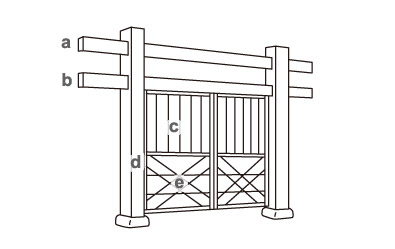|
||
 |
||


Old Takizawa
honjin êò{w (Fukushima)
@
(C)2001 Japanese Architecture and Art Net Users System.@No reproduction or republication without written permission.
fÚÌeLXgEÊ^ECXgÈÇASÄÌRec̳f¡»E]ÚðֶܷB
|
||||||
| @ | ||||||
| kuginukimon@BÑå | ||||||
| KEY WORD :@architecture / gates | ||||||
| @ | ||||||
| Also kuginuki BÑ. A roofless gate found at imperial tombs, mansions and government check points. When the gate has two penetrating tie beams, the lower one is called shita-no-nuki ºÌÑ, and forms the lintel against which the gates close. The upper tie beam is called ue-no-nuki ãÌÑ, and is as long as the lower one but is set approximately the diameter of one pillar above the lower tie beam. Sometimes there is only one penetrating tie beam with fences attached to the outer side of each post. In this case there are no doors and the gate has some resemblance to a Shinto gate *torii ¹. When the gate has doors, they resemble those of the doctor's gate *yakuimon òãå. The upper part of the doors, slightly greater than half the overall height, has a vertical lattice taterenji GAq, set at regular intervals. Characteristically, the lower area has x-shaped boards *tasuki æF, against a solid wood backing of horizontal boards. The two doors can be bolted when closed. | ||||||
| @ | ||||||

 Old Takizawa
honjin êò{w (Fukushima) |
||||||
@ |
||||||
| REFERENCES: | ||||||
| *kabukimon ¥Øå@ | ||||||
| EXTERNAL LINKS: | ||||||
| @@ | ||||||
| NOTES: | ||||||
| @ | ||||||
(C)2001 Japanese Architecture and Art Net Users System.@No reproduction or republication without written permission. fÚÌeLXgEÊ^ECXgÈÇASÄÌRec̳f¡»E]ÚðֶܷB |
||||||
| @ |